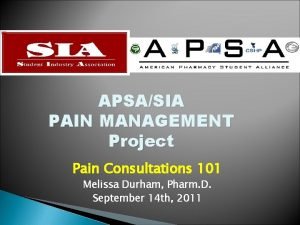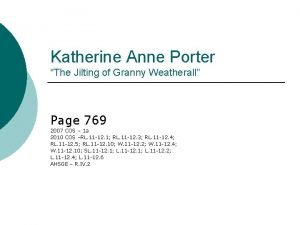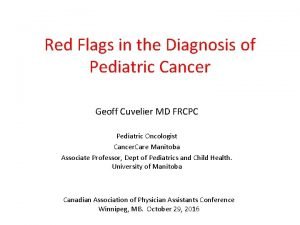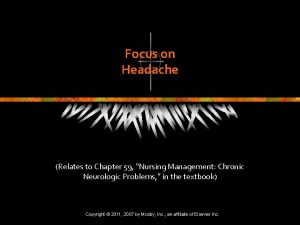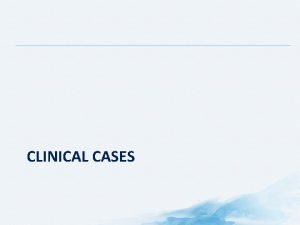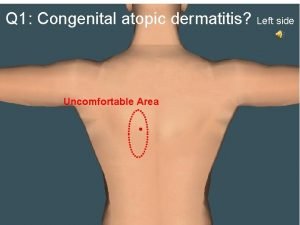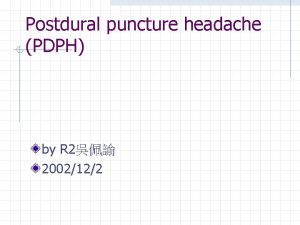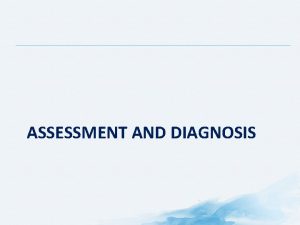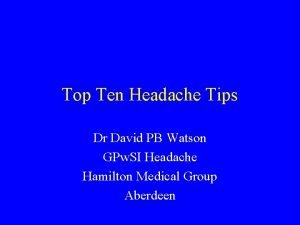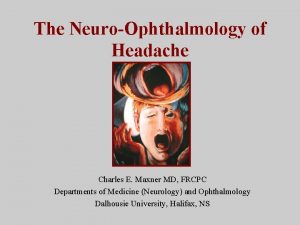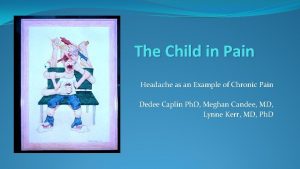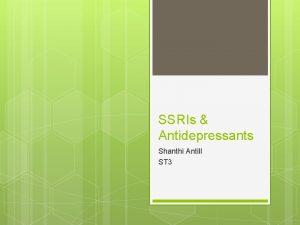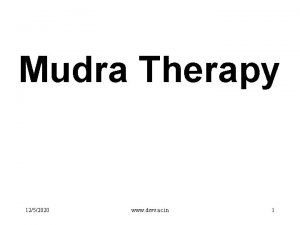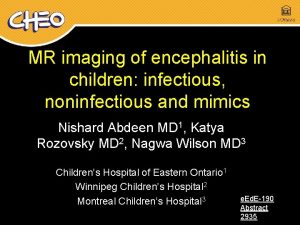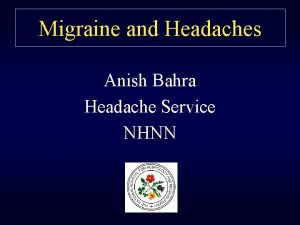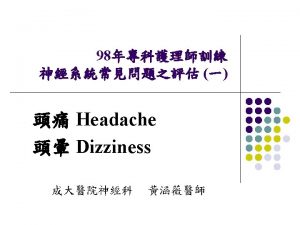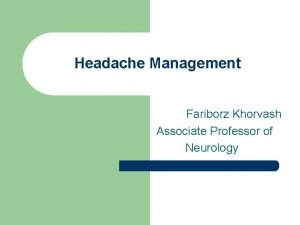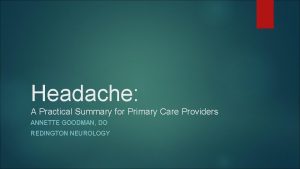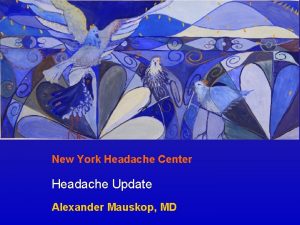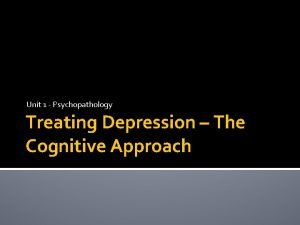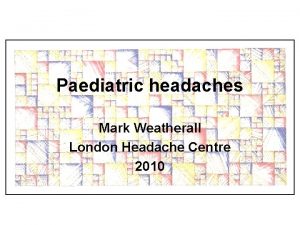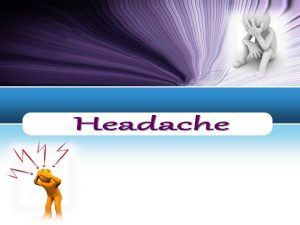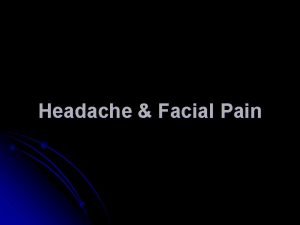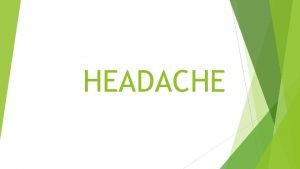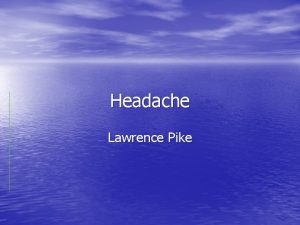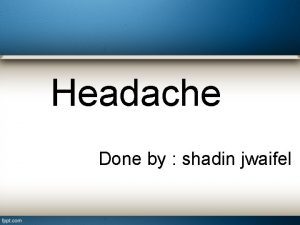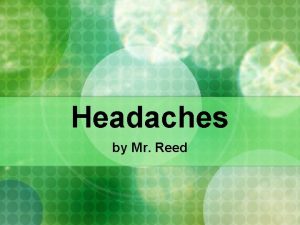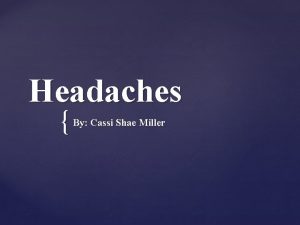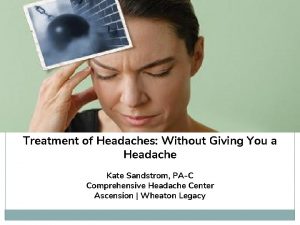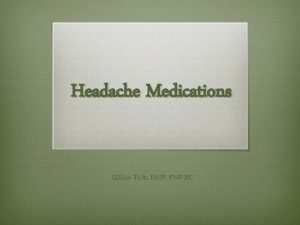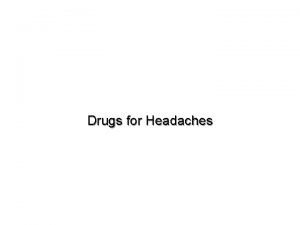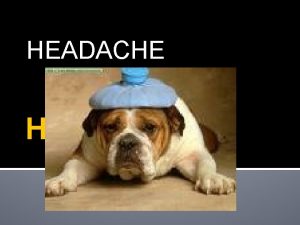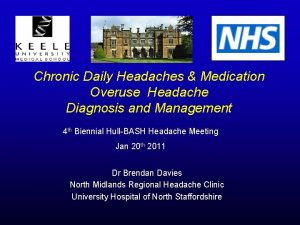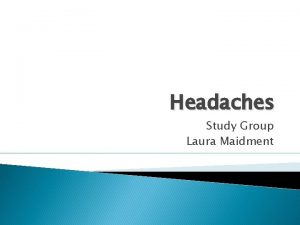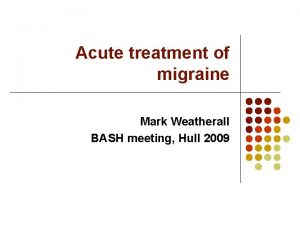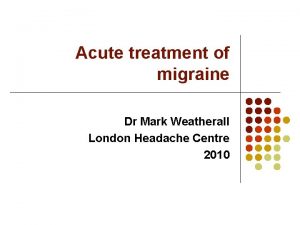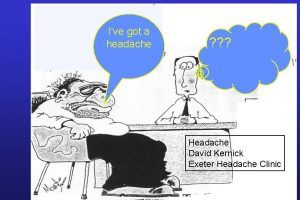Fundamentals of headache treating primary headaches Mark Weatherall

![To set the scene. . . “[Migraine] is a malady of which the student To set the scene. . . “[Migraine] is a malady of which the student](https://slidetodoc.com/presentation_image_h2/65955222ba8662b7eab45013bd0781c4/image-2.jpg)




























- Slides: 30

Fundamentals of headache: treating primary headaches Mark Weatherall BASH meeting Dartington Hall 2011
![To set the scene Migraine is a malady of which the student To set the scene. . . “[Migraine] is a malady of which the student](https://slidetodoc.com/presentation_image_h2/65955222ba8662b7eab45013bd0781c4/image-2.jpg)
To set the scene. . . “[Migraine] is a malady of which the student gains little practical knowledge in the course of his hospital work, unless he is so unhappy as to learn from the most effective of all instructors, personal suffering. . . It is common enough, but seems, to most of its subjects, by long experience so much an inevitable part of life that few seek relief. ” William Gowers (1906) “A doctor who cannot take a good history and a patient who cannot give one are danger of giving and receiving bad treatment” Anonymous

10 steps to success Get the diagnosis right Set realistic expectations Consider non-pharmacological measures Use the right drugs Use effective doses Treat early when the pains mild Treat associated symptoms Choose appropriate route of delivery Avoid medication overuse Use prophylactic treatments appropriately

1. Get the diagnosis right ‘migraine’ is the disorder and attack ◦ a situation analogous to epilepsy the disorder epilepsy is a tendency to. . . the attack: seizures ◦ in migraine, both share the same name ◦ the disorder is characterised by: the tendency to repeated attacks triggers sleep, food, weather, chemical (Et. OH/GTN), hormonal, sensory, stress-relaxation certain associations: hangovers, motion sickness, CVS family history

Migraine: headache + premonitory symptoms (20%+) ◦ tiredness , difficulty concentrating, neck stiffness, yawning, frequent urination – dopaminergic? headaches typically unilateral, throbbing ◦ associated with nausea +/- vomiting ◦ sensitivity to light, sound, smells, movement auras, usually visual, occur ~15 -20% of patients ◦ sensory, dysphasic, motor, olfactory frequently associated with disability ◦ WHO: a day of severe migraine ≈ quadriplegia

Migraine or TTH? recognise the disorder phenotype the worst type of attack the SPECTRUM study showed that in patients with headaches that met criteria for migraine, probable migraine, and TTH, all headache types responded to triptans ◦ this was not true for patients with purely TTH chronic TTH is very rare recurrent severe headaches are migraine, until proven otherwise

2. Set realistic expectations there is no ‘cure’ recognising the disorder goal setting ◦ trigger management ◦ effective acute treatment ◦ reducing attack frequency explaining the natural history arranging follow-up (if necessary)

3. Non-pharmacological measures lifestyle issues – the ‘boring life’? trigger management ◦ hormonal ◦ dietary ◦ psychological CBT, relaxation ◦ environmental ◦ sleep ◦ neck. . .

Then. . . 4. Use the right drugs 5. Use effective doses 6. Treat early when the pains mild 7. Treat associated symptoms 8. Choose appropriate route of delivery

Where to start? paracetamol 1 g or, aspirin 900 mg or, ibuprofen 600 -800 mg ◦ +/- domperidone 10 -20 mg taken as soon as possible*ª * i. e. as soon as the patient knows that this is a migraine or TTH ª if there is aura, take at the start of the headache phase

Variations on a theme if early nausea, you can use: soluble aspirin suppositories*: ◦ diclofenac 75 mg ◦ domperidone 30 mg *be French!



Problems, problems… not effective ◦ dose? timing? route? combination? diagnosis? contraindications ◦ asthma, upper GI problems, renal impairment side effects ◦ GI, CNS

This is what patients do next

Codeine…? … is NOT a treatment for headache ◦ the WHO analgesic ladder should NOT be applied to headache management

Triptans 5 -HT 1 B/1 D receptor agonists seven different formulations options for route of delivery ◦ oral tablets or melts ◦ nasal spray ◦ subcutaneous injection taken as soon as possible*ª¹ * i. e. as soon as the patient knows that this is a migraine ª if there is aura, take at the start of the headache phase ¹ this is a race against the development of allodynia

Headache response at 2 hr

Pain freedom at 2 hr

advantages disadvantages Sumatriptan well-established available OTC now the cheapest s/c, nasal spray expensive poorly absorbed Zolmitriptan cheaper long acting nasal spray, melt occasional confusion Naratriptan cheaper long acting slow onset Rizatriptan rapid onset melt high recurrence Almotriptan cheaper low SE incidence Eletriptan cheaper long acting pumped out of CNS Frovatriptan longest half-life slow onset

Problems, problems… ineffective ◦ dose? timing? route? switch? headache recurrence ◦ switch? combination with NSAID? contraindications ◦ HT, IHD SE ◦ nausea, GI, CNS, ‘triptan chest’


Then. . . 9. Avoid medication overuse 10. Use prophylactic treatments appropriately

Choice of preventive Rx likelihood of response likelihood of tolerability helpful additional properties ◦ anxiolytic, antidepressant, weight reduction logistical issues ◦ availability, monitoring je ne sais quoi

First line preventives tricyclics ◦ amitriptiline, dosulepin (50 -100 mg) anticonvulsants ◦ topiramate (50 mg bd), valproate (6001000 mg) β-blockers ◦ propranolol (40 -80 mg tds), atenolol (75100 mg) pizotifen (1. 5 -2 mg)

Second line preventives GON injection/s other anticonvulsants ◦ pregabalin (300 -600 mg) ◦ gabapentin (900 -1200 mg) vitamin B 2 (400 mg) Mg citrate (600 mg) Coenzyme Q 10 (450 mg) Botox (CM only – PREEMPT protocol)

Long shots. . . yet more anticonvulsants memantine ◦ levetiracetam, zonisamide, lamotrigine high-dose methysergide flunarizine phenelzine aspirin/clopidogrel olanzapine montelukast pizotifen lithium amiloride in-patient therapies ◦ IV DHE, IV steroids, IV valproate, lidocaine

In the end. . . start low, go slow, but get there use all available avenues: ◦ physio, CBT, biofeedback, specialist nurse the law of diminishing returns applies ‘first do no harm’ it is good to travel hopefully… but it is better to arrive… eventually

The future new drugs with novel targets ◦ serotonin subtypes; CGRP; glutamate; TRPV 1; nitric oxide; prostanoids; cortical spreading depression new delivery mechanisms for existing drugs ◦ inhaled DHE ◦ inhaled, transdermal, needle-free triptans transcranial magnetic stimulation

Thank you!
 Apsasia
Apsasia Hello song by peter weatherall
Hello song by peter weatherall Who is hapsy
Who is hapsy The jilting of granny weatherall timeline
The jilting of granny weatherall timeline Pediatric headache red flags
Pediatric headache red flags Infosys sabbatical leave policy
Infosys sabbatical leave policy Headache pain chart
Headache pain chart Headache red flags
Headache red flags Left side low abdominal pain
Left side low abdominal pain Pumcture
Pumcture Improved
Improved Postdrome symptoms
Postdrome symptoms Ophthalmoplegic migraine
Ophthalmoplegic migraine Headache
Headache Switching antidepressants chart
Switching antidepressants chart What is postictal confusion
What is postictal confusion Health education for meningitis slideshare
Health education for meningitis slideshare Mudras in yoga
Mudras in yoga Rasmussen's encephalitis
Rasmussen's encephalitis Anish bahra
Anish bahra Baep
Baep Snoop headache
Snoop headache Headache
Headache ı have a headache song
ı have a headache song Dr alexander mauskop
Dr alexander mauskop Headache
Headache European headache federation
European headache federation Chapter 24 lesson 2 preventing and treating stds
Chapter 24 lesson 2 preventing and treating stds Tumor treating fields mechanism of action
Tumor treating fields mechanism of action Cognitive approach to treating depression
Cognitive approach to treating depression Ethical issues in treating lgbt patients
Ethical issues in treating lgbt patients
